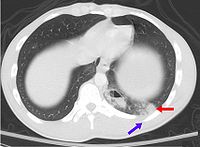
Photo from wikipedia
Endothelium lining interior surface of blood vessels experiences various physical stimulations in vivo. Its physical properties, especially elasticity, play important roles in regulating the physiological functions of vascular systems. In… Click to show full abstract
Endothelium lining interior surface of blood vessels experiences various physical stimulations in vivo. Its physical properties, especially elasticity, play important roles in regulating the physiological functions of vascular systems. In this paper, an integrated approach is developed to characterize the anisotropic elasticity of the endothelium under physiological-level fluid shear stress. A pressure sensor-embedded microfluidic device is developed to provide fluid shear stress on the perfusion-cultured endothelium and to measure transverse in-plane elasticities in the directions parallel and perpendicular to the flow direction. Biological atomic force microscopy (Bio-AFM) is further exploited to measure the vertical elasticity of the endothelium in its out-of-plane direction. The results show that the transverse elasticity of the endothelium in the direction parallel to the perfusion culture flow direction is about 70% higher than that in the direction perpendicular to the flow direction. Moreover, the transverse elasticities of the endothelium are estimated to be approximately 120 times larger than the vertical one. The results indicate the effects of fluid shear stress on the transverse elasticity anisotropy of the endothelium, and the difference between the elasticities in transverse and vertical directions. The quantitative measurement of the endothelium anisotropic elasticity in different directions at the tissue level under the fluid shear stress provides biologists insightful information for the advanced vascular system studies from biophysical and biomaterial viewpoints. STATEMENT OF SIGNIFICANCE: In this paper, we take advantage an integrated approach combining microfluidic devices and biological atomic force microscopy (Bio-AFM) to characterize anisotropic elasticities of endothelia with and without fluidic shear stress application. The microfluidic devices are exploited to conduct perfusion cell culture of the endothelial cells, and to estimate the in-plane elasticities of the endothelium in the direction parallel and perpendicular to the shear stress. In addition, the Bio-AFM is utilized for characterization of the endothelium morphology and vertical elasticity. The measurement results demonstrate the very first anisotropic elasticity quantification of the endothelia. Furthermore, the study provides insightful information bridging the microscopic sing cell and macroscopic organ level studies, which can greatly help to advance vascular system research from material perspective.
Journal Title: Acta biomaterialia
Year Published: 2022
Link to full text (if available)
Share on Social Media: Sign Up to like & get
recommendations!